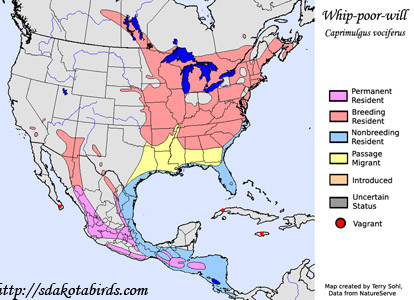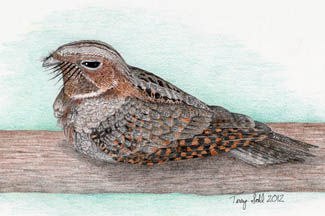| Length: 9 to 10 inches | Wingspan: 16 to 20 inches | Seasonality: Summer |
| ID Keys: Mottled gray and brown body, white tail corners (male), buff tail corners (female), rounded wingtips in flight. | ||
 The Whip-poor-will is heard more often than seen, as it chants
it's whip-poor-will in rapid succession, often for long periods of
time. During daylight hours, they sleep motionless on the forest floor,
and can be very difficult to spot because of their mottled camouflaged
feathering. Probably the easiest way to spot a bird in the daytime is
if the nest is approached too closely, which often prompts the parent to hover
in place while investigating the intruder. There are slight but distinct
differences in plumage and voice between eastern and western populations in
North America, and there is some who classify the two as different species.
The Whip-poor-will is heard more often than seen, as it chants
it's whip-poor-will in rapid succession, often for long periods of
time. During daylight hours, they sleep motionless on the forest floor,
and can be very difficult to spot because of their mottled camouflaged
feathering. Probably the easiest way to spot a bird in the daytime is
if the nest is approached too closely, which often prompts the parent to hover
in place while investigating the intruder. There are slight but distinct
differences in plumage and voice between eastern and western populations in
North America, and there is some who classify the two as different species.
Habitat: Prefers deciduous to mixed forests.
Diet: Insects, primarily night-flying insects.
Behavior: Nocturnal forager, although much of its foraging is done near dawn and dusk, or under the light of a nearly full moon. Captures insects by flying out from a perch and snagging them in mid-air, or by catching insects while in continuous flight.
Nesting: May and June
Song: A loud rolling whip-poor-will, repeated rapidly, sometimes for long periods of time . Click to listen to the Whip-poor-will song.
Migration: Summers throughout most of the eastern U.S., extreme southeastern Canada, and locally in the Southwestern U.S. Winters in the extreme southeastern U.S., Mexico, and Central America.
Interactive eBird map: Click here to access an interactive eBird map of Whip-poor-will sightings
Similar Species: Chuck-will's Widow, Common Nighthawk
Conservation Status: Has declined in number in the eastern United States in the past few decades, for reasons that aren't well understood.
Further Information: 1) USGS Patuxent Bird Identification InfoCenter, Whip-poor-will
2) Audubon Guide - Whip-poor-will
Photo Information: Photo courtesy of Andy Reaggo & Crissy McClarren
| Click on the map below for a higher-resolution view |
 |
| South Dakota Status: Common summer resident in the extreme southeastern part of the state. Casual migrant elsewhere. |
Additional Whip-poor-will Images
Click for a higher-resolution version of these photos

